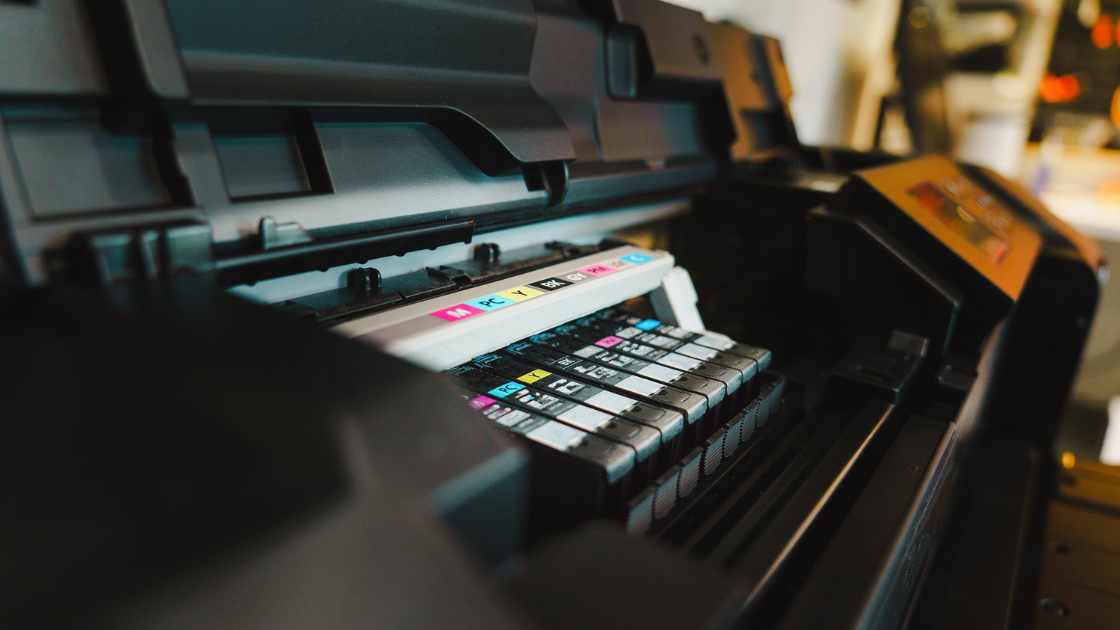Sublimation black may look blue due to incorrect color management settings or inadequate heat press conditions. To solve this, adjust your printer profiles and press time or temperature.
Perfecting the art of sublimation printing often requires overcoming a few hurdles, and getting true black colors instead of an unexpected blue tint is one of them.
The appearance of blue instead of black can be a frustrating issue for businesses and hobbyists alike, affecting the quality and consistency of their products.
When troubleshooting sublimation-related challenges, such as the phenomenon where “Sublimation Black Looks Blue,” it’s important to consider various contributing factors.
This issue often stems from issues like incompatible color profiles, inadequate heating, or incorrect pressure applied during the sublimation process. To overcome this, one must possess a thorough understanding of the equipment and the intricacies of the sublimation procedure.
Precise temperature control, proper pressure application, and the use of suitable sublimation ink all play crucial roles in addressing this concern.
By making meticulous adjustments and approaching the printing process with mindfulness, one can successfully achieve the desired rich and accurate black shade in their prints.
The Mystery Of Sublimation Black Appearing Blue

The Mystery of Sublimation Black Appearing Blue puzzles many. Have you ever printed a design, expecting a deep black, and instead received a shade of blue? This isn’t a simple printer error but a common issue in dye sublimation. Let’s explore what causes this and how it can be fixed.
Sublimation Printing
In sublimation printing, designs transfer from paper to fabric using heat. Printers infuse ink onto a special paper. Then, heat transfers the ink from the paper onto the material.
During this, the ink turns into gas and bonds with the fabric, resulting in long-lasting prints.
The Science Behind Color Shifts In Dye Sublimation
Color shifts occur due to different factors. One is printer calibration. If not properly calibrated, the printer may mix colors incorrectly. This often leads to black appearing blue.
Different factors like heat settings, transfer time, and pressure also affect the final hue.
- Heat Settings: Too much heat can alter the ink’s color.
- Transfer Time: Longer transfer times might cause color shifts.
- Pressure: Inadequate pressure can leave colors looking faded.
To fix the issue, try these steps:
- Calibrate your printer’s color settings.
- Adjust the heat press temperature.
- Test the transfer time needed for accurate colors.
- Check the pressure of the heat press.
Choosing the right type of ink and quality paper is also critical. These materials work together to give the purest black.
Issues can also stem from the fabric. Not all fabrics sublimate the same. Pick poly-rich fabrics to avoid unwanted blue tints.
Factors Influencing Black Color Outcome In Sublimation
Have you ever experienced sublimation prints where black appears as an unwelcome shade of blue? This color deviation can be perplexing and disappointing. In sublimation printing, perfecting the black color can be quite challenging.
Several factors can influence the quality and accuracy of the black tones produced. Let’s explore these critical elements that determine the final color outcome when printing black via sublimation.

Substrate Materials And Their Impact On Color
The right choice of substrate is essential for obtaining true black in sublimation. The sublimation process involves a transition from a solid to a gas, and the medium on which this gas settles can dramatically affect the final color.
- Fabrics: Polyester fabrics often yield better results compared to cotton-blend materials.
- Hard Substrates: The coating on mugs, tiles, or metals must be sublimation-ready to prevent color shifts.
It is vital to select high-quality substrates specifically designed for sublimation to ensure true color portrayal.
Ink Quality And Printer Configurations
Premium-grade inks and correctly configured printers are key for achieving the desired black color.
| Ink Quality | Printer Settings |
|---|---|
|
|
Ensuring proper ink quality and printer configurations are essential steps toward achieving a perfect black in your sublimation prints.
Common Challenges With Black In Sublimation Printing
Printing a perfect black color in sublimation can be tricky. Often, black turns out more like a deep blue.
This happens due to color calibration issues, the quality of the sublimation ink, printer settings, or the substrate being used. Getting true black is about the process and precision in executing it.
Color Management For True Black Reproduction
Good color management is essential for accurate black reproduction. It starts with using a high-quality sublimation printer and ink. The correct color profile for your printer is essential.
It ensures that the black you see on-screen is the black that gets printed. Utilize ICC profiles and color-calibration software to get the desired results.
- Choose the right ICC profile for your printer-substrate combination.
- Calibrate your monitor regularly to ensure color accuracy.
- Test print on the same material as your final product.
The Role Of Heat And Pressure In Color Variation
Heat and pressure play a huge role in sublimation printing. If not applied correctly, they can alter the final color. For black to be truly black, both parameters must be exact.
Temperature consistency and even pressure ensure color vibrancy and fidelity. It’s important to use a reliable heat press machine that can maintain the recommended temperature and pressure throughout the printing process.
- Set the heat press to the right temperature for your substrate.
- Ensure even pressure for uniform color transfer.
- Adjust pressure based on the thickness of the substrate.
Preventive Measures To Maintain Color Fidelity
Preventive Measures to Maintain Color Fidelity are essential in any sublimation printing process. When black prints out as blue, it’s often a sign that something’s not quite right.
Thankfully, there are steps you can take to ensure your prints reflect true-to-life colors. By calibrating your equipment and using the correct ICC profiles, you can get closer to achieving the perfect print.
Calibrating Equipment For Accurate Colors
Color calibration is the key to accurate sublimation. It aligns your printer’s output with known color standards. Here’s what you need to do:
- Check your printer’s calibration regularly to combat shifts in color accuracy.
- Use calibration tools like a spectrophotometer to measure the printer’s color output.
- Adjust printer settings according to the calibration device’s feedback for precise colors.
Calibration should take place in your target lighting condition for best results. Regular checks and adjustments ensure continuous color accuracy, preventing unwanted blue-tinted black.
The Importance Of Using The Right ICC Profiles
ICC profiles are the instruction manuals telling your printer how to create accurate colors on a given substrate. To utilize them right:
- Select the proper ICC profile for the printer, ink, and transfer paper you’re using.
- Install the ICC profile into your printing software. Guidance is typically provided by the profile creator or printer manufacturer.
- Double-check settings before sending your design to print to ensure the profile is applied.
Using the correct ICC profile can make a dramatic difference. It helps translate colors from your design to your print accurately, keeping blacks black, not blue.
Troubleshooting The Blue Hue In Black Sublimation
Discovering a blue hue in black sublimation prints can be confusing and frustrating. The rich, deep black expected turns into an unsightly blue tinge. An array of factors could cause this discrepancy, from printer settings to the choice of ink and paper.
This section dives into practical solutions to troubleshoot and resolve the blue hue problem in black sublimation prints, ensuring that the final product matches the desired outcome.
Adjusting Printer Settings For Optimal Results

Printer settings play a pivotal role in print quality. For sublimation, calibration is key. Starting with color management in the print software, make sure to select the profile specific to the sublimation ink being used.
Each ink has its color gamut, and using the correct profile ensures colors translate correctly from screen to print. Adjust the printer’s color density settings. A higher density might be necessary to achieve a true black without the blue undertone.
- Check software for ink profiles.
- Increase color density setting to reduce blue hue.
- Run test prints after each adjustment.
Ink And Paper Selection To Combat Color Issues
The right combination of ink and paper is vital. Quality sublimation ink designed specifically for your printer model can make a significant difference. Cheaper inks may lead to inconsistent color outcomes.
Similarly, using high-grade sublimation paper ensures better ink transfer and absorption, providing more accurate color representation in the final product.
| Ink Type | Paper Type | Results |
|---|---|---|
| Specific brand-compatible | High-grade sublimation | Accurate colors |
| Generic | Standard | Inaccurate colors |
- Use compatible inks for your printer.
- Select high-quality paper for better results.
- Avoid generic inks and papers that cause color shifts.
Step-by-step Guide To Fixing The Blue-Black Problem
Ever printed a design thinking it’s the deepest shade of black, only to find it has a blue hue? This common issue can be a real headache.
Fear not, though! Here’s a step-by-step guide to banish the blue and get true black from your sublimation prints.
Software Tweaks To Refine Color Balance

Getting the right color balance starts with your software settings. Follow these tweaks to shift from blue to black:
- Check ICC profiles: Ensure your printer is using the correct ICC profile. This tells your printer about color management.
- Adjust color settings: In your printer properties or design software, find the color adjustment section. Tweak black levels here.
- Calibrate your monitor: A well-calibrated monitor shows true colors. Use calibration tools to align your screen.
- Update printer drivers: An outdated driver might mess up colors. Always keep your printer’s driver current.
Post-printing Processes To Enhance Quality
Once your item is printed, there are steps to perfect the final product:
- Heat press check: Incorrect temperature and time can affect color. Ensure your heat press settings match the substrate.
- Quality inks matter: Use high-quality sublimation inks for better color representation.
- Test print regularly: Always do a test print. This helps catch color issues early.
- Cooling process: Let your items cool properly. Rushing can change the final color.
Exploring Solutions Beyond The Printer
Welcome to the insightful exploration of color dilemmas in sublimation printing! Sometimes, black doesn’t print as the pure deep black we expect but rather has a blue hue.
It’s frustrating and can affect the quality of your work. Fear not! The quest to solve this mystery goes well beyond your printer settings.
We’re diving into the environmental and advanced techniques that can bring back the true black to your prints.
External Environmental Factors Affecting Output
Your print environment plays a vital role in the final color output. These aspects could be key to your problem:
- Humidity levels must be consistent. Too high or too low can alter how ink behaves.
- The quality of the sublimation paper matters. It can influence ink absorption and release.
- Heat press temperature and time settings are vital. Calibrate them regularly for accurate results.
Let’s address these factors with actionable steps:
- Keep a humidity monitor in your workspace to check levels often.
- Invest in high-quality sublimation paper to maintain color fidelity.
- Use a heat press test kit to ensure accurate temperature readings.
Advanced Techniques For Professional Printers

When standard practices don’t cut it, there are advanced measures for experienced printers eager to perfect their craft:
- ICC profiles guarantee consistent color. They adjust for specific printers, inks, and papers.
- Software solutions like RIP control color management more finely.
For those ready for a deeper sink, consider these advanced tactics:
- Work with a color expert to create a custom ICC profile for your setup.
- Explore RIP software options to take full control of your color output.
Frequently Asked Questions Of Why Does Sublimation Black Looks Blue And How To Solve It
Why Is My Sublimation Black Not As Black?
Sublimation black may not appear truly black due to incorrect color profiles, low-quality ink, insufficient heat during transfer, or inadequate pressure. Ensure all settings and materials match your printer’s specifications for optimal results.
Why Is My Sublimation Coming Out Blue?
Sublimation might come out blue due to incorrect temperature settings, an overused sublimation paper, or a color profile issue in your printer settings. Ensure accurate heat levels and check for proper color management.
How Do You Fix Sublimation Colors?
To fix sublimation colors, adjust your printer color management settings, use the correct ICC profiles, check ink and paper quality, ensure optimal heat press temperature and time, and maintain consistent pressure during transfer.
Is There A Way To Sublimate On Black?
Sublimating on black fabric directly is not possible due to the dye’s transparency. Instead, use a special polymeric spray or printable heat transfer vinyl that white-prints the design before sublimation, allowing the colors to show on black material.
Why does my sublimation look so dark?
The sublimation process may appear excessively dark due to factors such as incorrect temperature or pressure settings, leading to over-saturation of the ink.
Adjusting these parameters according to the specific requirements of the substrate and ink used can help achieve a more accurate and vibrant sublimation result.
How do I stop sublimation from shadowing?
To prevent sublimation from causing shadowing, ensure that the substrate surface is uniformly coated with a sublimation coating and maintain consistent heat and pressure during the sublimation process to achieve even dye penetration.
Avoid using excessive ink and ensure proper substrate alignment to minimize the risk of shadowing in the final sublimated product.
Conclusion
The nuances behind sublimation printing can significantly improve your black prints, ensuring they no longer exhibit an unintended blue hue. Proper calibration, ink quality, and substrate choice are key. Apply these solutions and watch true, deep blacks transform your projects from amateur to professional with striking clarity.
Keep experimenting; perfect prints are on the horizon.

